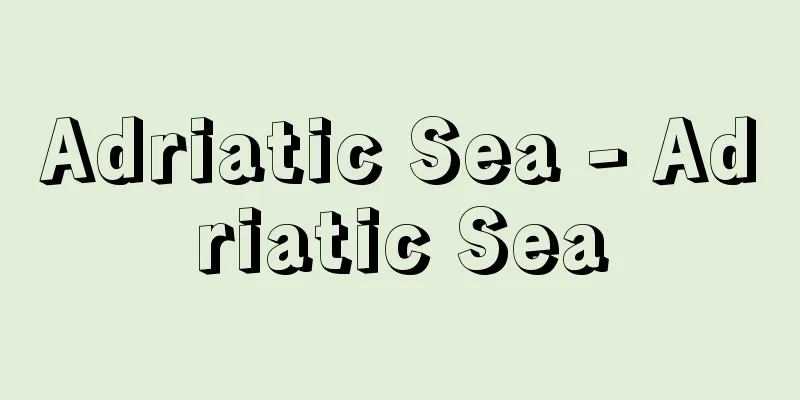Adriatic Sea - Adriatic Sea

|
A part of the Mediterranean Sea, between the Italian and Balkan peninsulas. It stretches from the Strait of Otranto in the southeast to the Gulf of Venice and the Gulf of Trieste in the northwest, with a length of about 800 km and a width of about 90-200 km. Its area is about 132,000 square km. The Italian coastline is generally monotonous, except for the delta of the Po River and the lagoons of Venice and Grado. In contrast, the coastline from Slovenia to Croatia, where the Dinaric Alps run through and karst topography is widespread, has a lot of in and out of the coast, and many islands are scattered offshore. The sea depth is generally shallower in the northwest and deeper in the southeast, with the Tremiti Islands as the border. The maximum depth is 1,250 meters. The water temperature is 25°C in summer, but in winter, due to the cold northeasterly winds and shallow sea depth, it drops to 5-6°C in the northwest. The salinity ranges from 33 to 38, but decreases the further in, with the Gulf of Venice showing the lowest salinity in the Mediterranean. Since ancient times, it has been an important maritime trade route, and since the 8th century BC it has been under the control of the Etruscans, Greeks, Romans, and the Byzantine Empire. After the 10th century, it gradually came under Venetian influence, and especially until the Geographical Discovery, it played a crucial role as a trade route connecting Europe and Asia. Currently, there are ports and resorts such as Trieste, Venice, and Brindisi on the Italian side, and Rijeka, Split, and Dubrovnik on the Croatian side. [Kenichi Sakai] [References] |Located in southwestern Croatia, it is the center of Adriatic tourism. Roman ruins remain, including Diocletian's Palace. World Heritage Site "Historic Site of Split and Diocletian's Palace" (Croatia, registered in 1979) Split, Croatia ©Masashi Tanaka "> Split city Source: Shogakukan Encyclopedia Nipponica About Encyclopedia Nipponica Information | Legend |
|
地中海の一部をなし、イタリア半島とバルカン半島に挟まれた海域。南東端のオトラント海峡から北西端のベネチア、トリエステ両湾へと、長さ約800キロメートル、幅約90~200キロメートルで広がる。面積約13万2000平方キロメートル。イタリア側の海岸線は、ポー川のデルタ地帯、およびベネチアやグラードのラグーン地帯を除けば、概して単調である。それに対して、ディナル・アルプス山脈が走り、カルスト地形が広範にみられるスロベニアからクロアチアにかけての海岸線は、出入りが激しく、沖合いには多くの島々が散在する。海深はトレミティ諸島を境にして、一般に北西部に浅く、南東部に深い。最深部は1250メートル。水温は、夏季には25℃になるが、冬季になると冷たい北東風ボラと海深の浅さのため北西部では5~6℃にまで下がる。塩分濃度は33~38の幅をもつが、奥に入るほど低下し、ベネチア湾では地中海中で最低の濃度を示す。古来、重要な海上交易路で、紀元前8世紀以降エトルリア人、ギリシア人、ローマ人、ビザンティン帝国などの支配下にあった。10世紀以後、徐々にベネチアの影響下に入り、とりわけ地理上の発見まではヨーロッパとアジアを結ぶ通商路として決定的な役割を果たした。現在イタリア側にはトリエステ、ベネチア、ブリンディジ、クロアチア側にはリエカ、スプリト、ドゥブロブニクなどの港や保養地がある。 [堺 憲一] [参照項目] |クロアチア南西部に位置するアドリア海観光の中心地。ディオクレティアヌスの宮殿など、ローマ時代の遺跡が残る。世界文化遺産「スプリトの史跡群とディオクレティアヌス宮殿」(クロアチア・1979年登録) クロアチア スプリト©Masashi Tanaka"> スプリト市街 出典 小学館 日本大百科全書(ニッポニカ)日本大百科全書(ニッポニカ)について 情報 | 凡例 |
Recommend
Palace calendar - Denryaku
This is the diary of the Kanpaku and Grand Minist...
Chimori-sho
A manor belonging to Todaiji Temple in Asuwa Coun...
Espartinha - Espartinha
…a simple sandal-style footwear similar to straw ...
Townspeople and aristocrats
Original title, French: Le Bourgeois gentilhomme ....
Anglo-Britannica Dictionary
…Thus, the 17th century can be said to be the age...
Kyǒng-In ch'ǒlto (English name)
The first railway in Korea was built with Japanese...
Liquid discharge - Electric discharge
…In the latter case, the energy source is limited...
Dissociative anesthetics
…It is an intravenous anesthetic that has a stron...
Kimoto - Kimoto
<br /> This is one of the methods for making...
Law of Heaven - Tensoku
〘 noun 〙 The law determined by heaven. The law of ...
Fowler, C.
…The first example of an orangery is said to have...
Ueno Zoo - Ueno Zoo
Its official name is Tokyo Onshi Ueno Zoological ...
Sebeok, TA (English spelling) SebeokTA
… [Toshiyuki Kitamori] [Application to social sci...
dehiscent fruit
…Fruits can be classified based on the shape of t...
Damnacanthus major
…[Mr. Makoto Fukuoka]. … *Some of the terminology...









